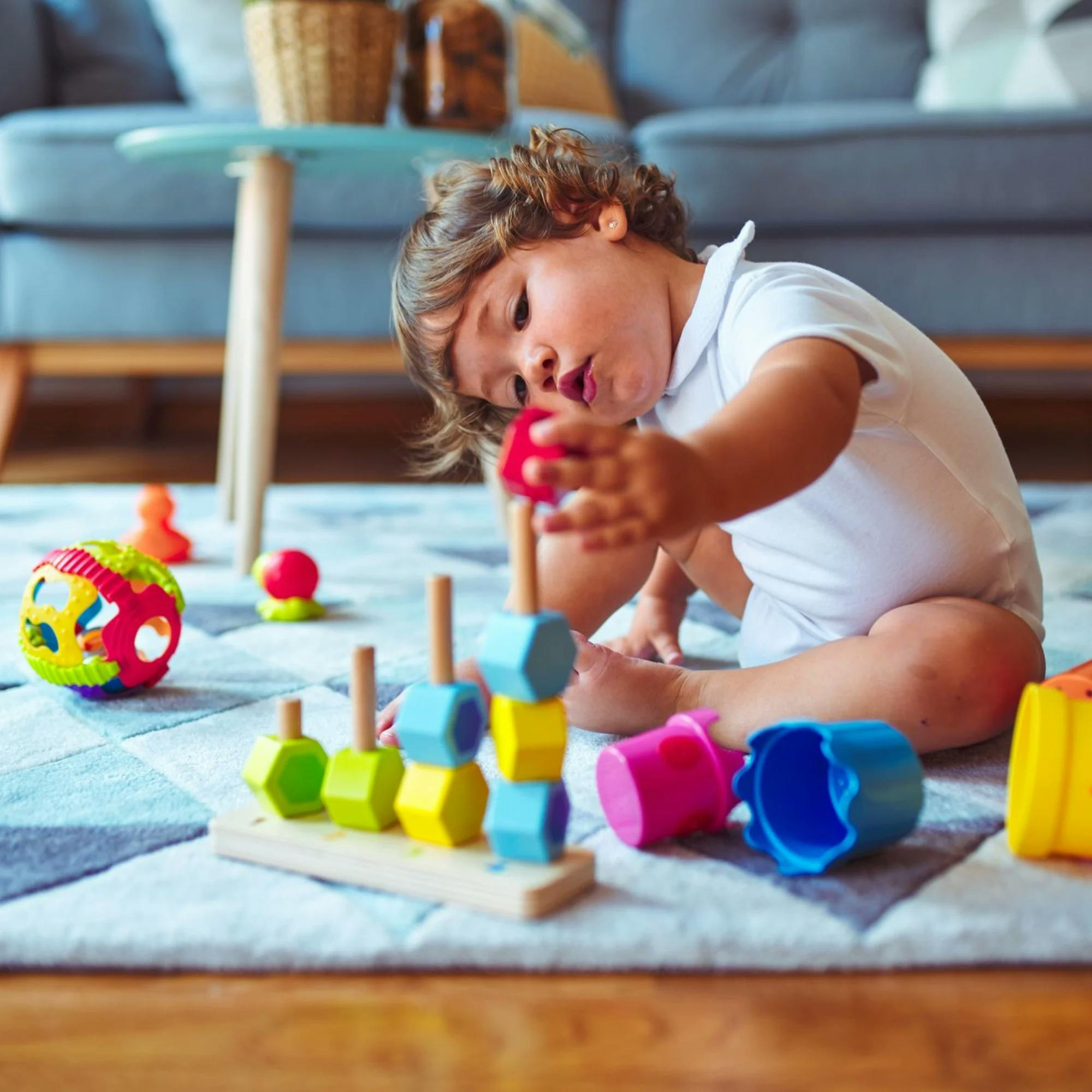If you have a child, you’ve probably received your fair share of advice (whether you want it or not!). And some of that advice may be about your child’s speech and language development. Perhaps something like “Don’t baby-talk to them, they need to hear big words.” Or maybe this old favorite: “They’ll talk when they want to; you just need to be patient!”
Let’s uncover the truth behind some outdated (or just plain false) beliefs about children’s speech and language, from what to do about a speech delay to whether videos can help your toddler learn to talk. While friends and family members might mean well, it’s important to understand the research about childhood communication development–and when speech therapy might be needed.
1. “Baby talk is bad”
Ever notice that your voice instinctually changes when you speak to a baby or toddler? You might say nonsensical words or change the tone of your voice. That’s essentially the definition of “baby talk.”
Baby talk might sound like this: “Drink your wawa” (for “Drink your water”) or “Put your shoesies on your wittle toesies” (as you put on your child’s shoes).
While this type of baby talk is a powerful way to get a child’s attention, there’s no real functional language being used. And though it might encourage your child to imitate you, ultimately we don’t want children to learn and repeat incorrect grammar or silly words.
However, this doesn't mean speech therapists recommend talking to your baby as you would an adult. The answer lies somewhere in the middle. This “middle ground” is called parentese.


Parentese, which is also called "motherese" or "infant-directed speech," is grammatically correct speech that uses the exaggerated tones and animated faces of baby talk. However, it avoids replacing actual words with silly sounds or incorrect grammar.
With parentese, you’re still using proper speech and correct words, but you're changing the tone and melody of your voice. For example, with parentese you wouldn’t call a bottle a “baba,” or a train a “choo-choo.” (You can certainly use “choo choo” to make train noises, but not to name the train itself!)
Some characteristics of parentese include:
Speaking in a higher pitch
Elongating your vowels
Speaking slowly and clearly
Exaggerating your facial expressions
Using a variety of engaging voice inflections.
Check out this quick (and adorable) video showing parentese in action!
Speech therapists encourage using parentese since research has shown its benefits. For example, one study compared babies whose caregivers used parentese and spoke to them often with babies whose caregivers didn’t use this approach. The babies in the first group babbled much more between ages 6 and 14 months. At 14 months, they spoke significantly more words than the second group of babies.
In addition, it’s best to use simple words and sentences that are more easily understood. Don’t focus on big words with your toddler. They need to hear functional words that they’ll be more likely to begin using when they talk, like the names of favorite people and objects.
2. “They’ll talk when they want to, just wait it out”
If you’re concerned your child might have a speech delay, you may have heard this advice from a friend or relative. Some children follow a different timetable, and your child might be right on track with their development. But trust your gut. If you’re worried, it’s always worthwhile to have an evaluation with a speech therapist.
Your friend might tell you not to worry–their son was a late talker, then started speaking in complete sentences at age 3. However, speech therapists don’t usually recommend the “wait-and-see” approach. Waiting runs the risk of delaying necessary treatment. It also puts children at risk of being delayed longer, or even more severely. Children's speech and language skills build on one another. A delay in meeting milestones now may affect the ability to gain skills 6 months down the road (and beyond.)
If you'd like to learn more about speech and language milestones at each age, visit our Learning Center, where we cover communication milestones from birth through high school. You can also take our free communication screener to see how your child compares with typical milestones for their age.


3. “Using baby sign language will keep your child from learning to talk”
This is a common misconception, and it’s easy to see how people might believe it. But actually, it couldn’t be further from the truth! If anything, teaching a young child sign language along with a verbal model (saying the word) promotes language development.
Remember, before children say their first words, they express their needs using nonverbal communication: crying, pointing, gesturing, etc.
Teaching your baby simple signs and gestures enables them to express their wants and needs more easily than doing the oral motor planning–moving their lips, tongue, jaw, etc.–needed for words. Using the sign for “more” is a lot easier for a child who hasn’t even said “Mama” yet. And often, the more tools a child has to help them communicate, the less likely they’ll need to resort to unwanted behaviors (think tantrums!).
As a child imitates more sounds and words, the use of gestures typically fade out. But in the meantime, wouldn't you rather your child gesture “all done” than throw the rest of their food on the floor?


4. “Educational videos can teach your toddler to talk”
This is another popular belief with many parents and caregivers. When there are so many shows and videos that aim to teach children their numbers and letters, or even how to talk, it makes sense.
However, let’s look at this claim a little more closely. Kids may learn some things from TV shows. They may even begin imitating words they hear on screen. And that’s great! But functionally using those words in day-to-day situations is very different from imitating the words heard on TV.
Let’s say a toddler imitates a show host saying “Hi!,” but they don’t actually use the word with other people as a greeting. It’s still beneficial that your child imitated the word, but we want them to learn how to use that word during everyday life. This is why it’s best for children to learn to talk by interacting with other people in real life, practicing and hearing new words and phrases in the moment.
Apart from this, too much screen time isn’t good for language development. For one example, take a look at this research. This study showed that greater amounts of screen time were associated with a higher likelihood of developmental delays in communication. Here are the numbers:
With up to 2 hours of daily screen time use at age 1, children were 61% more likely to have communication delays at age 2.
With 2 to 4 hours of daily screen time at age 1, 2-year-olds were twice as likely to have a communication delay.
With more than 4 hours of daily screen time, 2-year-olds were five times more likely to have a communication delay.
If you’re concerned about your child’s speech, it’s always best to seek out a speech therapist who can formally evaluate and interact with your child, rather than using educational videos.
5. “Having the right toys can help your child learn to talk”
When you’re constantly bombarded with ads for the newest, most high-tech toys, it’s easy to think that certain types of toys can help kids reach their full potential. Don’t worry–it’s just not true. Think about the times you’ve been excited to give your child a gift, and they’re more interested in the tissue paper. Well, sometimes simple, everyday materials are what get our kids’ attention best. And these simple items may even promote better play and communicative interactions.
You can use pots and wooden spoons to make musical instruments and learn new songs. You can build a garage or house out of cardboard boxes, or head outside to play with water in plastic bowls and cups. You can cook or bake together and use descriptive words about the food you’re making. You can draw pictures with chalk on the sidewalk and learn new vocabulary words.


Keep in mind, too, that the toys your child does have can be used in a variety of ways. You don’t need a lot of different toys to help your child with speech and language.
Let’s take a teddy bear, for example. You can use it to teach your child pretend play, like pretending to feed the bear or put him to sleep. You could also use it to teach your child the names of body parts, like nose, ears, tummy, and eyes.
If the teddy bear is up high on a shelf, see if your child will ask you to get it down. You can even model for them a word or phrase to see if they’ll imitate you, such as “Bear?” or “Get down.”
In addition to toys, think about everyday experiences you can share with your child. Going to the park or the grocery store provides so many opportunities to teach language to your child. Talking about going down the slide, or sitting in the cart, or deciding between red or green apples are simple activities that are also fun and engaging ways to practice speech and language.
We know how much information is out there for parents to make sense of. If you have concerns or questions about your child’s speech, start the process to get matched with a speech therapist. We’re here to help!
How Expressable Can Help
Concerned your child isn't reaching age-expected milestones? Looking for communication support from a professional? Expressable is a national online speech therapy practice serving children and adults. We treat all major areas of communication and feeding, offer flexible hours including evenings and weekends, and accept most major health insurance plans. We’re proud to have earned more than 3,000 5-star reviews from our clients (4.9/5 average).
Our therapy model is centered on parent and caregiver involvement. Research proves that empowering caregivers to participate in their loved one’s therapy leads to better outcomes. That’s why we combine live, 1-on-1 speech therapy with personalized education and home practice activities for faster progress.
Communication is more than words. It’s how we share how we feel and show who we are. We’re here to help you or your child do just that.

 Abby Barnes, M.S., CCC-SLP
Abby Barnes, M.S., CCC-SLP








